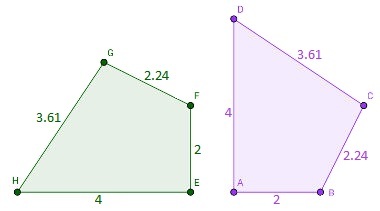For two geometric figures to be considered congruent it is necessary that the corresponding sides of these figures have equal measures and that the same happens with their corresponding angles. For this reason, you need to measure all sides and all angles of both figures to compare them and decide if they are congruent.
Saying that two figures are congruent is something like saying that they are equal. This statement cannot be made just because we are talking about two different figures that have the same measurements. To understand this, imagine two rectangles, one green and one blue, with the following measurements:

These rectangles are not the same, but their side measurements match.. In order for them to be congruent, it is enough that corresponding angles are equal. And they are! It is a property of rectangles that all their angles measure 90 degrees. Soon, these two different rectangles are congruent in that they have equal corresponding angle and side measurements.
To make it easier to understand the corresponding sides and angles, note the two quadrilaterals (figure with four sides) below:

These two Quadrilaterals are congruent, however, note that corresponding sides and angles do not occupy the same position. Here is a scheme of corresponding sides:
HE = DA = 4
EF = AB = 2
GF = BC = 2.24
GH = CD = 3.61
The same reasoning holds for any pair of geometric figures that have the same number of sides.
Example
Which of the following pairs of figures might be congruent?


The first pair of figures has pentagons that can be congruent. In this case, these pentagons are regular, so they have all equal angles and thus are congruent.
The second pair of figures refers to non-congruent figures. They have four sides, but the measurements of some corresponding sides are different and therefore not congruent.
By Luiz Paulo Moreira
Graduated in Mathematics


